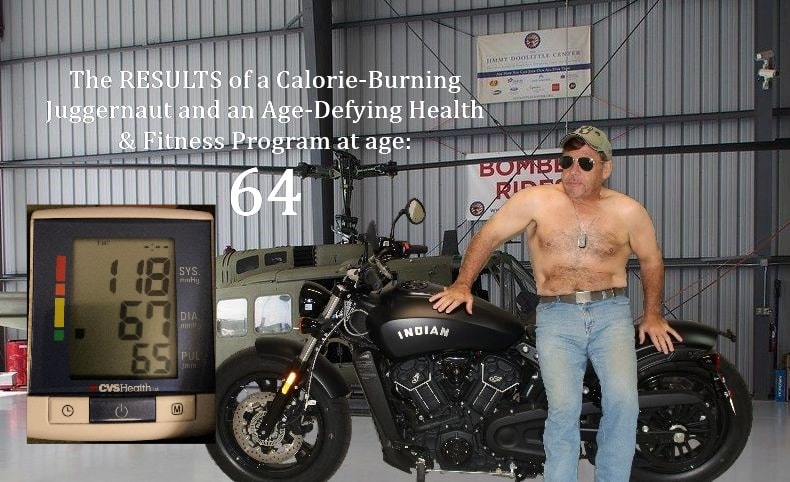THE QATSPY® Quapaw Aviation Tactical Sportswear Performance Yukon Outfitters
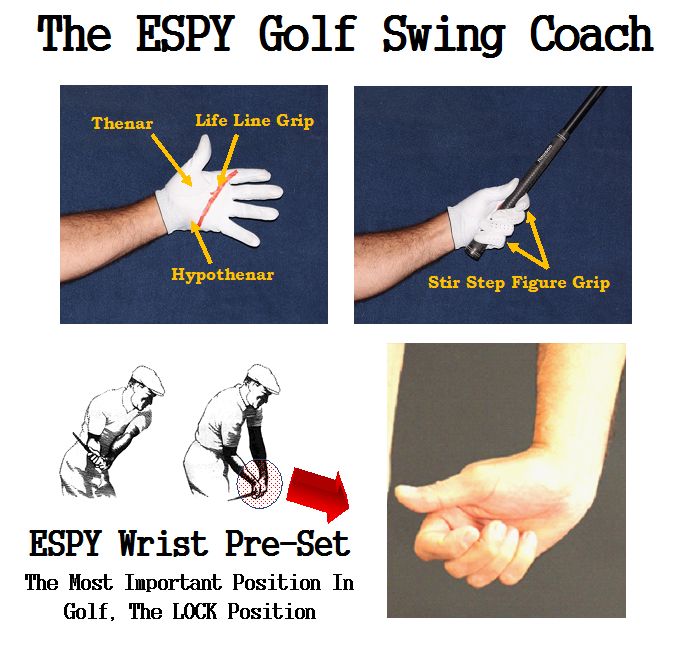
By: Charles W. Boatright
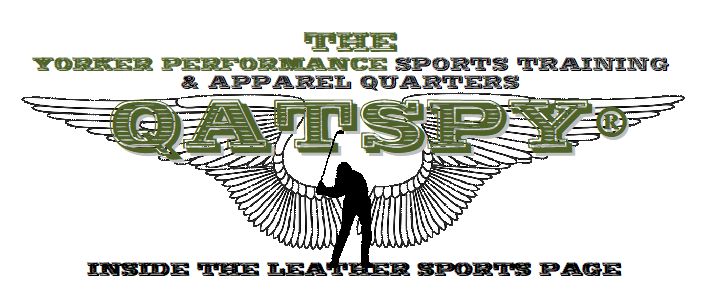
HYPOTHENAR, GOLF SWING TECHNIQUE REFERENCED BY BEN HOGAN– Placing the Hypothenar into the Lock Position with a Sync & Preset Technique
Mr. Bobby Jones, Mr. Ben Hogan, Mr. Arnold Palmer, and Mr. Jack Nicklaus are, in my opinion, are four of the most fundamentally accomplished golfers in addition now with Tiger Woods. Two of the most important fundamentals of the golf swing that they stressed to the average golfer was how to establish a proper grip that is in more along the lifeline of the palms of the hands than the fingers and to preset the wrists action in the golf swing. Ben Hogan even referenced the Hypothenar as an important reference point in the golfer’s golf swing mechanics. The Hypothenar is one of two muscles in the wrists that has direct contact with the handle of the club (refer to illustration below).
This golf swing technique can even be searched on the Internet with the key search words– “hypothenar” and “Ben Hogan.”
Also Mr. David Leadbetter, a PGA Instructor, describes this Preset/Lock Position in an article that he wrote in the January 2012 issue of Golf Digest that I will explained later in this article.
The Thenars, the Only Muscles that Have Contact with the Handle of the Golf Club
Let me explain why the Thenar and the Hypothenar are important to the golfer standing on the Tee Box, as well as, to the baseball batter standing in the batter’s box. Of all the muscles (ALL 640 in total in the human body) there are only two muscles that have direct contact with the handle of the golf club and/or the baseball/softball bat. These are the golfer’s and baseball batter’s Thenars (Thenar and Hypothenar).
Since I’m right-handed, I consider my left Hypothenar as the shaft of my golf club; and the right Hypothenar are the clubface. This allows me to have an integral link to my golf club more like a baseball batter has with the bat.
That should be and would be enough to capture my attention right off the bat, no pun intended. This should be and would be all I would need to know for me to take note of these muscles and how they work with each swing.
During my ergonomics and kinesiology studies, I did a research project that I did I called the Xerox Box Study. My professors stressed the importance of the thenars (Hypothenar and Thenar) in sports and how they are used, particularly the hypothenars to maximize the function of the lower forearms, or wristbands and wrists. This caused me to do research on the role of the hypothenar has during the golf swing sequence and compare the golf swing to that of the baseball swing. This research and analysis became what I called my Xerox Box Golf Project. Even Ben Hogan, in the late 50’s, realized the importance of the Hypothenar in the golf swing.
The control point for the maneuver of the left and right Hypothenar is a nodule called the Ulna Styloid Process where the wrist and lower forearm join each other. These are the only control points that the golfer has to be focus on to Sync and Preset their wrists into the Lock Position, (shown below and in my training videos).
Two of the Strongest Muscles that have Direct Contact with the Handle of the Golf Club, The Thenars
Bobby Jones, Ben Hogan, and Arnold Palmer took advantage of the wrists’ two largest and strongest muscles, the Thenar and the Hypothenar, by placing the handle of the golf club diagonally under the Hypothenar, just along the lifeline to the index Proximal Phalanx finger (first section of the index finger), where the yellow line is in the Figure No. 1, Top Left.
This yellow line is shown in the featured image, that I traced on my left hand glove, allows you to see the importance of how the Thenars play an important role in the golfer’s swing mechanics. There are two muscles/tendons that enact with the Thenars, called the Brachio-Radialis and the Palmaris Longus Muscles/Tendons in Figure No. 2, below. I just told you all the muscle memory that a golfer needs to develop to make their golf game more consistent with Power, Acceleration, and Clubhead Speed. The entire job for the golfer is to just Sync/Preset their wrists into the Lock Position, shown in Figure No. 3. If the golfer just does this, their whole golf game would be revolutionized and significantly more simple as their baseball swing is to them.
Here’s the question- How many times did you have the same issues standing in the batter’s box that you experienced standing on the Tee box, I would guess NEVER!
But first, let me help you shorten the names of these two Muscles/Tendons- The Brachio-Radialis is simply called BRACHS, like the name of the candy company. The Palmaris Longus is simply called Palmer, in honor of Arnold Palmer. These are set using the Ulna Styloid Process as control points. What is nice about these two control points and maneuvers is that they can be done while at your desk or at home.
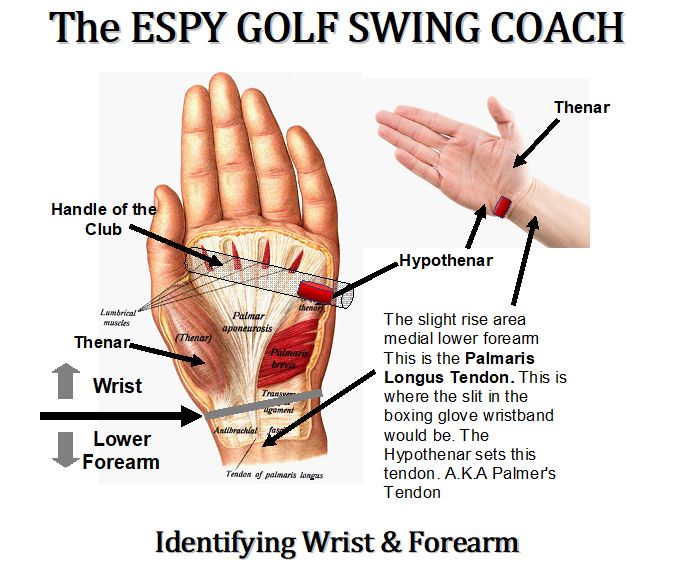
Let me show you in Figure No. 3 below what the golfer’s wrists should look like from the Address Position into the Lock Position just after the golfer preset the wrist action in the golf swing. Ninety percent (90%) of the golfer swing is completed in this Lock Position.
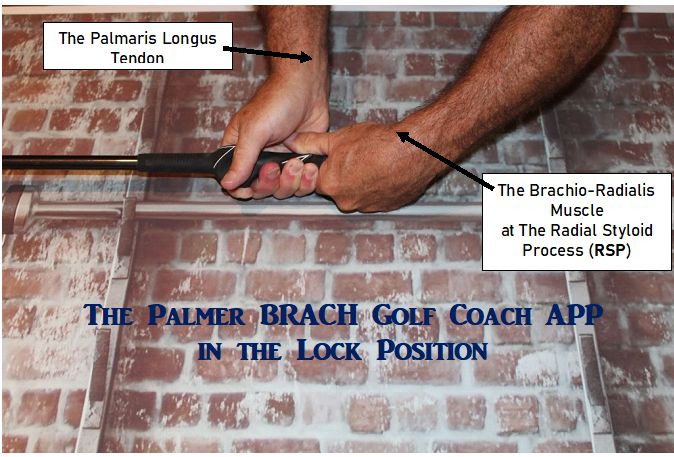
Take note of my right hand in the Lock Position, in Figure No. 1 and No. 3, you might have heard professional golfer reference a mental image of trying to cover up the golf ball with their right hand in the case of a right-handed golfer. This is exactly what Sync/Preset Technique does.
The Hypothenar and Thenar are the only two muscles capable of transferring that much torque from the forearms to the handle of the club and to the head of the golf club. There are no other muscles/tendon that has direct contact with the handle of the club than the Thenars and the Palmer Tendon, refer to Figure No. 2. Particularly, the hypothenar, thenar, and the thumbs that act similar to stabilizers through impact. The right and left hypothenars synchronize with the right and left thumbs to preset the wrists and handle of the club.
Once I have addressed the golf ball, by placing the clubhead behind the golf ball, my entire attention is only on my Ulna Styloid Process, Hypothenars and what baseball batters call the Strike Zone. I mentally more the golf ball from the ground into my strike zone. Everything takes place in my Strike Zone, because it allows me to just swing the handle of the club and not the entire golf club. This is exactly what Eddie Merrins talks about in his golf lessons and video series.
This is the exact mental image I want to have standing on the Tee Box, from the fairway, and around the Green in Figure No. 4 and 5, Below:
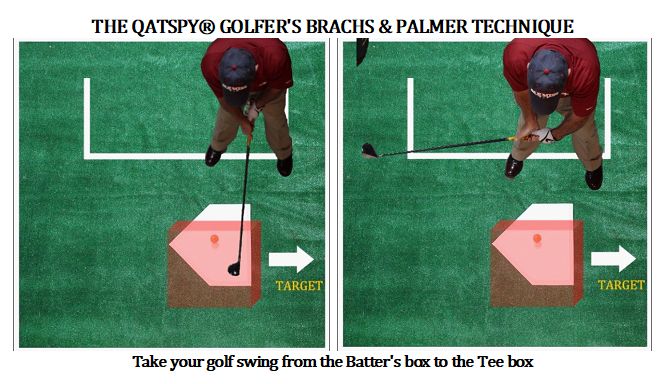
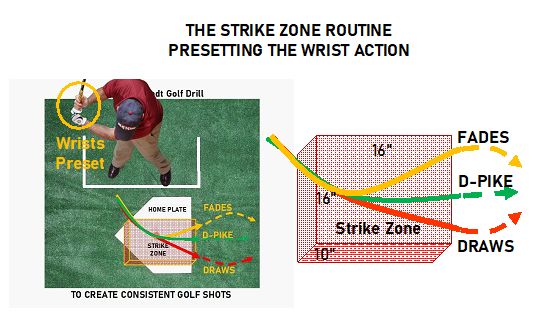
Figure No. 4 and 5 are what allows me to PLAY IN THE ZONE, in this case it would be the Strike Zone. I explain this golf swing approach in my four (4) Videos below, what I call my Orange Bucket Challenge. Now I’m using special golf balls called AlmostGOLF Balls that are hit and measure in feet instead of yards. I use these AlmostGOLF Balls, because the Television camera crew shooting this expressed concern during pre-production meeting that if I used actual golf balls that they couldn’t capture where my shots were landing in regards to the Home Depot Orange Bucket. But, the first video is the same preset wrist action used to hit driver, used to hit pitch shots in my golf training facility.
MY Orange Bucket Challenge Videos:
The Bunt-Type Chip Shot
THE Orange Bucket Challenge Link INTRO
The Orange Bucket Challenge Walk-Through
The Orange Bucket Challenge Demo
These videos above were a part of an actual interview that I did for a local Television Station (WJTV-12 in Jackson, MS), that they aired during their sports show called Sports ZONE leading up to the 2021 US OPEN. The production crew took excerpts for these videos to make a promo for Golf Instruction that they aired Sunday night after the US OPEN. The video below was that PROMO:
Just a note- All of these videos were done on the first take.
Get a Grip on Your Golf Swing
At address, I personally like to place the handle of my golf club in left hand beside my left pocket, just to set the proper grip and naturally orientate the left thumb that represents the handle of the club. When I bring the handle of the club into my Address Position, I place my right hand over my left thumb. My right thumb represents the clubface in one of three (3) orientations, Strong, Neutral, or Weak Grips. My personal grip preference is to use a baseball grip- (ten-finger) type grip. This is discussed in the April 2016 issue of Sports Illustrated Golf Magazine on page 63, where the 10-finger grip frees up the backswing for more power, speed, and control. Also, the 10-finger grip gives me a feeling of a baseball batter in the batter’s box.
All of what I just described and Illustrated Above Sets Up Three (3) Major Advantages for the Golfer:
FIRST ADVANTAGE– This keeps the golfer’s swing confined to a 16- inch x 16- inch x 10- inch depth space, or the Strike ZONE as I like to described it, like a baseball batter. This allows for the golfer to keep everything within the hands that are located on the handle of the golf club, as shown in Figure 5. This provides the golfer with approaching their golf swing using instinctive motor skills (muscle memory) that they developed playing baseball/softball rather then trying to remember swing thoughts that are actually useless on the Tee box.
SECOND ADVANTAGE– Provides the golfer the ability of approach their golf swing using their baseball/softball mentality based on instincts (muscle memory). Using instincts developed when we were kids playing sand lot baseball or softball, this provides golfer with a golf swing that can be repeated with a high degree of confidence. And Confidence is KING IN SPORTS!
If the golfer is going to improve their golf game and have confidence in their golf game, their golf swing has to be instinctive. These instinctive skills are what the golfer will have to rely, these are motor skills that were developed before the age of 12. We only have one shot at developing these motor skills. These are also instinctive motor skills we will have to rely on standing on the Tee box.
There was a great article that supports my baseball-type approach to the golf swing in the January 2002 issue of GOLF DIGEST on starting page 54. This was an article written by David Leadbetter entitled Your New Swing Starts Here, Eliminate your Takeaway mistakes with the ‘Swing of the Future’. What Mr. David Leadbetter and I are talking about and are using is a baseball-type swing to develop a golf swing that can be instinctive for you here the golfer doesn’t even have to think.
This is the every reason why golfer experience what I call THE GAP- When you can’t take what you worked on during practice sessions or coaching lessons to the golf course. The very first question that the golfer will asked themselves is– What happened to what I just worked on just 5- minutes ago? I can answer that question in the THIRD ADVANTAGE Below.
THIRD ADVANTAGE– Here why this is important to the golfer’s game- How many times can you remember playing baseball/softball standing in the batter’s box and having the same difficulties of that when you are standing on the Tee box. In baseball/softball standing in the batter’s box you didn’t even think about your swing mechanics. You were just focused on the pitch (moving between 70-90 MPH) and your Strike Zone.
In golf, however, you’re focused on a ball that doesn’t move, this is passive. We need to convert our golf swing from passive into an active mode, just like a batter does swinging their bat into the Preset/Lock Position, in Figure No. 3, before taking our hands and handle of the club to the top of our swing, in Figure No. 5.
I did a photograph where I super imposed by golf swing over my baseball swing. What I’m demonstrating here is me trying to hit a pitch that is low and inside, like a sinker ball pitch.
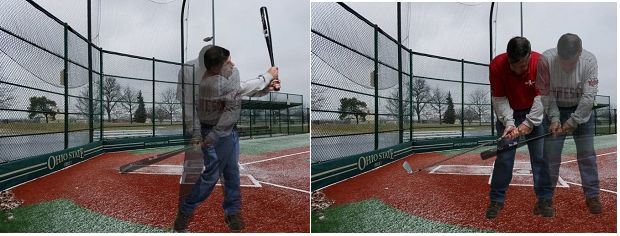
This is What I can Guarantee the GOLFER
I can guarantee the GOLFER THIS ONE THING– When the golfer practice in the backyard or on the range, the golfer is using their conscious part of their mind. They are going thought processes to develop a golf sequence of what they want to do on the golf course. But I can guarantee the golfer this one thing, that when the golfer step foot onto the golf course their subconscious mind will take over the entire golf swing using instincts. If your golf swing isn’t instinctive those hours that the golfer spent practicing had just been scraped by your subconscious.
I have written a book that is on KINDLE called THE KASPER GOLF SWING & FITNESS COACH, the following link can take you to KINDLE to purchase my NEW E-Book:
For those that would like to also have my DELPHI DIET & FITNESS System, I have my second book on KINDLE below:
Since 90 percent of sports and especially golf is mental, I have written my third book THE SPORTS BIBLE- THE YELLOWSTONE PAPERS based on sports psychology for a stronger game plan:
This article is Sponsored by;
THE QATSPY® YORKER Personalized-Style & Tradition Apparel Quarters
THE QATSPY® AMERICAN CLASSIC LEATHER JACKET COLLECTION
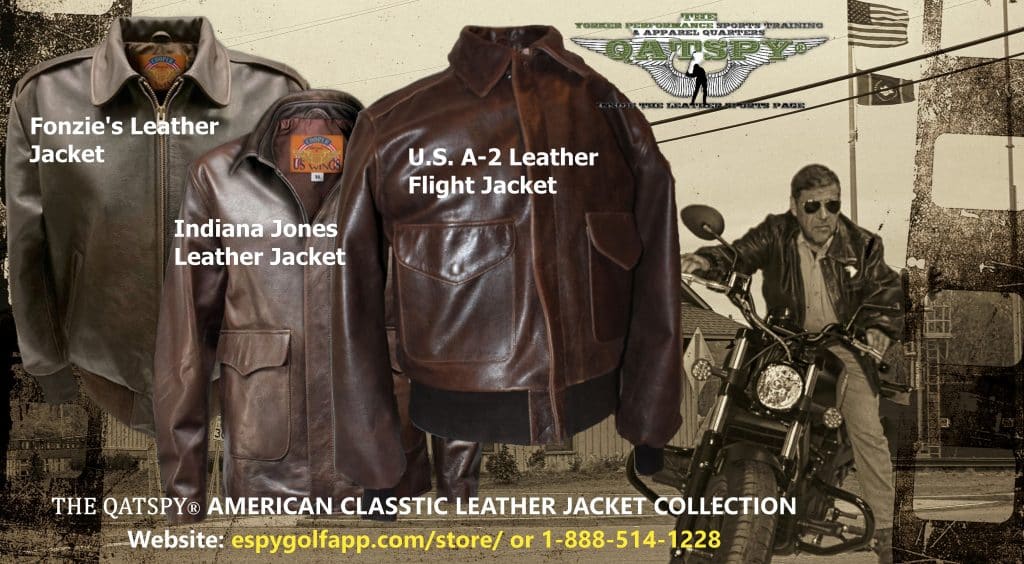
The U.S. A-2 Leather Jacket has been a major part of our history (both military and civilian) since 1931 when the U.S. Army Air Corps developed and issued the leather flight jacket to pilots during World War II. A version of this iconic and classic A-2 Leather Flight Jacket became the persona of two legendary entertainers/actors- Fonzie in Happy Days and Indiana Jones in Raiders of the Lost Ark.
As Fashionable are our US WINGS® Jackets are, your best fashion is Your Fitness In the photograph below, I’m 64 years old. This photograph was taken after we did a FALL & WINTER Photo shoot (09Nov21) for our line of US WINGS® Leather Jacket that I carry in our online store. The camera crew challenged me to an AB Challenge where I’m posing without my shirt. I credit my DELPHI DIET & FITNESS System for my physical condition, and the condition of my skin.
The ESPY Golf Swing Technique
Two of the Strongest Muscles that have Direct Contact with the Handle of the Golf Club
The Hypothenar Preset Golf Swing Technique
This placement of the golf club handle, right below the bottom half of the left Hypothenar (I’m right-handed), will allow the golfer to properly preset the wristband, as professional golfers, like Ken Duke and Marco Dawson, encourage. This allows the golfer to incorporate the Thenar and Hypothenar to transfer power from the lower and upper body through the forearms. The key to the preset position is using the Hypothenar and Thenar in the wrist.
I want to visualize a “J” and a “U” in my left and right palms, shown below, of my hands, respectively, to help Sync/Preset my golf swing. It is important to think about the Hypothenar as the pivot hinge and the Thenar as the head of a hammer. The “J” and “U” are laid out in the palms of my hands below. If the golfer uses this J-U golf swing technique, they will not only realize more distance, but also more control. This is a picture perfect golf swing technique.

The J & U Golf Swing Technique to gain more distance and control.
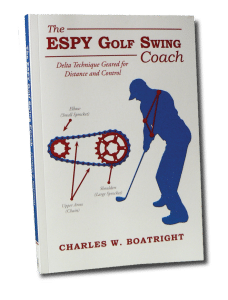
After the reader looks at the illustration, they will understand why these two elements are important in the golf swing sequence. Boxing gloves are a great mental image to Sync/Preset the wrists. The left and right Hypothenars act like a stabilizer. This synchronizes the handle of the club with the body. Remember, the shaft of the club is just the extension of the forearms. The golfer is concentrating on swinging the handle of the club, instead of the golf club, as noted by Eddie Merrins, who produced a series of videos entitled Swing The Handle, not the club.
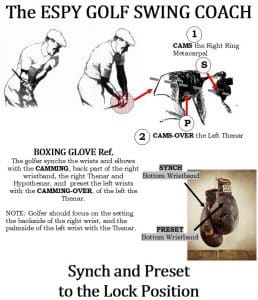


The ESPY Golf Swing Coach– Price for Paperback $15.75 and E-Book $8.99, Hardback is also available on my website: www.espygolfapp.com/store OR your local bookstore and also:
Amazon.com http://www.amazon.com/The-Espy-Golf-Swing-Coach/product-reviews/1483416356
Barnes & Noble.com http://www.barnesandnoble.com/w/the-espy-golf-swing-coach-charles-w-boatright/1120604749
Check out my full library of BLOGS @ www.espygolfapp.com/blog or purchase your copy of “The ESPY Golf Swing Coach” @ www.espygolfapp.com/store.
Facebook – The QATSPY Golf Approach
Twitter – @cwboatright
Google+ – ESPY Golf Swing Coach
YouTube – ESPY Golf Swing Coach
Once you learn WHY, you don’t forget HOW!
YouTube Videos:
https://youtu.be/ZGVNrIw_wlo (Cam & Cam-over elements)
https://youtu.be/K2FDHZ3AX9w (Figuring your proper swing plane)
https://youtu.be/TO82PMO6G8M (Developing muscle memory)
A Recommendation for your Golf Game:
I would like to recommend a wonderful radio program that I regularly listen to on my I-Heart Radio app on KARN 102.9 FM station, out of Little Rock, AR. They air a golf show called “Arkansas Fairways and Greens,” at 7:00 AM CT each Saturday morning, hosted by Bob Steel and Jay Fox. Bob occasionally has on his show a guest named Shawn Humphries, a Professional Golf Instructor from Dallas, Texas. One thing that Mr. Humphries stresses is the mental part of golf, not focusing on the results but the process.
Until next time– Be Synched, Tee-to-Green, with The ESPY Golf Swing!

